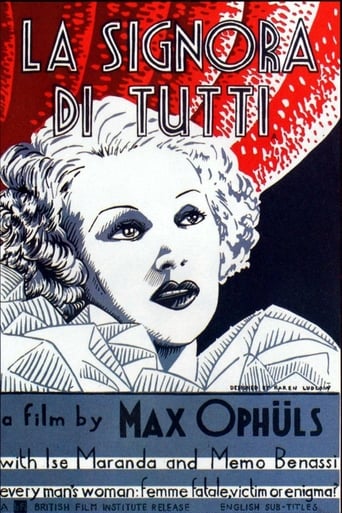happytrigger-64-390517
Max Ophüls directed so many masterpieces with great actor direction in great and sad love stories. All that shot with a virtuoso camera (travellings or real time shots like in "Madame De" or "Letters From An Unknown Woman").All these masterpieces are available. But there is one hidden masterpiece directed by Max Ophüls and it is one of his first movie : "La Signorra Di Tutti", only available in Italy (where it was shot, Ophüls was an international director). And it is an incredible masterpiece with again some virtuoso cinematography and narration (flashbacks in flashbacks). It is a powerful love drama with insane scenes.Sure Orson Welles watched it and provided him so many ideas. And 20 years later, Ophüls directed his most well known movie, "Lola Montès", with the same story.It is urgent to release this hidden treasure for real cinema lovers.
dbdumonteil
In Max Ophuls'work,if you were born a woman,you were born to suffer.If there are exceptions,they are very rare : from "Liebelei" where a woman's true love was only a "liebelei" to "Sans Lendemain" where Edwige Feuillère was prisoner of a racy past to "letter from an unknown woman " where Joan Fontaine 's love was in vain to the masterpieces of the fifties "Madame de" and "Lola Montès" .Even in the much debated "De Mayerling à Sarajevo" the historic Sophie Chotek (Feuillère again) character was also a humiliated woman."La signora di Tutti" actually predates "Lola Montès" by twenty years:it's a long flashback after the heroine's suicide.The first sequences are nervy ,tense,the dialog begins with numbers and you soon realize they're talking about money.Isa MIranda portrays with talent a woman whose biggest fault is to be all along the film the right woman in the wrong place.Every man she loves leads her to a dead end : the music teacher,the businessman,his son.Great scenes:the opera ,an imaginary way for the lovers to escape ;Ophuls's great fascination for the trains (see also "letter to an unknown woman" "De Mayerling à Sarajevo" and even the "la maison Tellier" segment in "LE Plaisir" in a comic way);Alma's tragic death ,the shadow of the wheelchair on the wall,the radio which Gabriella smashes ; and above all,the final pictures when the press slowly stops .A strong influence on Mankiewicz ("Barefoot Comtessa" ),Louis Malle (" Vie privée")and on the melodrama genre (Sirk)The flashback was not so innovative after all(the year before,Stahl did the same in "only yesterday" ) but the directing which sometimes has thriller accents (the scene when the heroine hears a radio nobody can't hear would not be out of place in a psychological suspense;ditto for the wheelchair scene in the night which is really awesome.
Mario Naito
Signora di tutti is truly one of the most underrated films of movie history. When I saw it ten years ago I was marveled about its modernity although belonging to 1934. I´m sure Welles undoubtely watched it before filming Citizen Kane, because Max Ophuls´s narration and editing techniques in that picture somehow anticipated Orson´s landmark screen jewel. This movie deserves a standout place in the development of film language.
Kalaman
"La Signora di Tutti" is the only film the maestro Max Ophüls made in Italy and it already confirmed his genius. The film - an eloquent and often tragic study of an ill-fated movie star Gaby Doriot who rises her way to a depressingly patriarchal world and later becomes a victim of its cruelty - is certainly nowhere near the richness, splendour, and lilting mastery of Ophüls' celebrated later classics, but it is fascinating in its own ways. The intricate flashback structure and the beautiful Isa Miranda's heartbreaking incarnation of the spoiled Gaby seem to anticipate Ophüls' later works, particularly his final masterpiece, "Lola Montes" (1955). The film is apparently not for every taste but if you are a fan of Ophuls as I am, it is an indispensable viewing.



